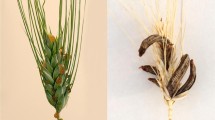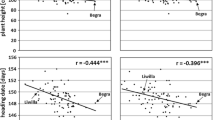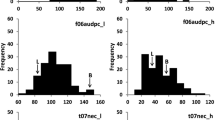Abstract
Key message
Four QTL conferring resistance to ergot were identified in the UK winter wheat varieties ‘Robigus’ and ‘Solstice’. Two QTL co-located with semi-dwarfing alleles at the Rht loci Rht - 1B and Rht - 1D implicating a role of these DELLA proteins in infection success of Claviceps purpurea.
Abstract
The fungal pathogen Claviceps purpurea infects ovaries of a broad range of temperate grasses and cereals, including hexaploid wheat, causing a disease commonly known as ergot. Sclerotia produced in place of seed carry a cocktail of harmful alkaloid compounds that result in a range of symptoms in humans and animals, causing ergotism. Following a field assessment of C. purpurea infection in winter wheat, two varieties ‘Robigus’ and ‘Solstice’ were selected which consistently produced the largest differential effect on ergot sclerotia weights. They were crossed to produce a doubled haploid mapping population, and a marker map, consisting of 714 genetic loci and a total length of 2895 cM was produced. Four ergot reducing QTL were identified using both sclerotia weight and size as phenotypic parameters; QCp.niab.2A and QCp.niab.4B being detected in the wheat variety ‘Robigus’, and QCp.niab.6A and QCp.niab.4D in the variety ‘Solstice’. The ergot resistance QTL QCp.niab.4B and QCp.niab.4D peaks mapped to the same markers as the known reduced height (Rht) loci on chromosomes 4B and 4D, Rht-B1 and Rht-D1, respectively. In both cases, the reduction in sclerotia weight and size was associated with the semi-dwarfing alleles, Rht-B1b from ‘Robigus’ and Rht-D1b from ‘Solstice’. Two-dimensional, two-QTL scans identified significant additive interactions between QTL QCp.niab.4B and QCp.niab.4D, and between QCp.niab.2A and QCp.niab.4B when looking at sclerotia size, but not between QCp.niab.2A and QCp.niab.4D. The two plant height QTL, QPh.niab.4B and QPh.niab.4D, which mapped to the same locations as QCp.niab.4B and QCp.niab.4D, also displayed significant genetic interactions.





Similar content being viewed by others
References
Akbari M, Wenzl P, Caig V, Carling J, Xia L, Yang S, Uszynski G, Mohler V, Lehmensiek A, Kuchel H, Hayden MJ, Howes N, Sharp P, Vaughan P, Rathmell B, Huttner E, Kilian A (2006) Diversity arrays technology (DArT) for high-throughput profiling of the hexaploid wheat genome. Theor Appl Genet 113:1409–1420
Alexander J, Benford D, Boobis A, Ceccatelli S, Cottrill B, Cravedi J, Di Domenico A, Doerge D, Dogliotti E, Edler L, Farmer P, Filipič M, Fink-Gremmels J, Fürst P, Guérin T, Knutsen HK, Machala M, Mutti A, Rose M, Schlatter J, van Leeuwen R (2012) EFSA panel on contaminants in the food chain (CONTAM): scientific opinion on Ergot alkaloids in food and feed. EFSA J 10:2798, 1–158. doi:10.2903/j.efsa.2012.2798
Appleford NE, Lenton JR (1991) Gibberellins and leaf expansion in near-isogenic wheat lines containing Rht1 and Rht3 dwarfing alleles. Planta 183:229–236
Bayles R, Fletcher M, Gladders P, Hall R, Hollins W, Kenyon D, Thomas J, West J (2008) Towards a sustainable whole-farm approach to the control of ergot. HGCA Project No. 2992. LINK Project code LK0963
Broman KW, Sen Ś (2009) A guide to QTL mapping with R/qtl. Statistics for biology and health, Springer Science + Business Media, LLC. doi 10.1007/978-0-387-92125-93
Broman KW, Wu H, Sen Ś, Churchill GA (2003) R/qtl: QTL mapping in experimental crosses. Bioinformatics 19:889–890
Cheng H, Qin L, Lee S, Fu X, Richards DE, Cao D, Luo D, Harberd NP, Peng J (2004) Gibberellin regulates Arabidopsis floral development via suppression of DELLA protein function. Development 131:1055–1064
Cooke RC, Mitchell DT (1966) Sclerotium size and germination in Claviceps purpurea. Trans Br Mycol Soc 49:95–100
De Costa C (2002) St Anthony’s fire and living ligatures: a short history of ergometrine. Lancet 359:1768–1770
De Groot AN, van Dongen PW, van Roosmalen J, Eskes TK (1993) Ergotamine-induced fetal stress: review of side effects of ergot alkaloids during pregnancy. Eur J Obstet Gynecol Reprod Biol 51:73–77
Diethelm M, Schmolke M, Groth J, Friedt W, Schweizer G, Hartl L (2014) Association of allelic variation in two NPR1-like genes with Fusarium head blight resistance in wheat. Mol Breed 34:31–43
Dill A, Thomas SG, Hu J, Steber CM, Suna T (2004) The Arabidopsis F-Box protein SLEEPY1 targets gibberellin signaling repressors for gibberellin-induced degradation. Plant Cell 16:1392–1405
Draeger R, Gosman N, Steed A, Chandler E, Thomsett M, Srinivasachary, Shondelmaier J, Buerstmayr H, Lemmens M, Schmolke M, Mesterhazy A, Nicholson P (2007) Identification of QTLs for resistance to Fusarium head blight, DON accumulation and associated traits in the winter wheat variety Arina. Theor Appl Genet 115:617–625
Fulton TM, Chunwongse J, Tanksley SD (1995) Microprep protocol for extraction of DNA from tomato and other herbaceous plants. Plant Mol Biol Rep 13:207–209
Genstat 12 Committee (2009) Genstat for Windows release 12.0 VSN International, Wilkinson House
Hilton AJ, Jenkinson TW, Hollins TW, Parry DW (1999) Relationship between cultivar height and severity of Fusarium ear blight in wheat. Plant Pathol 48:1365–3059
Holland JB, Nyquist WE, Cervantes-Martinez CT (2010) Estimating and interpreting heritability for plant breeding: an update, chapter 2. Plant Breed Rev 22:9–112
Huang BE, George AW, Forrest KL, Kilian A, Hayden MJ, Morell MK, Cavanagh CR (2012) A multiparent advanced generation inter-cross population for genetic analysis in wheat. Plant Biotechnol J 10:826–839
Lin F, Xue SL, Zhang ZZ, Zhang CQ, Kong ZX, Yao GQ, Tian DG, Zhu HL, Li CJ, Cao Y, Wei JB, Luo QY, Ma ZQ (2006) Mapping QTL associated with resistance to Fusarium head blight in the Nanda2419 × Wangshuibai population. II: type I resistance. Theor Appl Genet 112:528–535
Lorieux M (2012) MapDisto: fast and efficient computation of genetic linkage maps. Mol Breed 30:1231–1235
Mantle PG, Shaw S (1976) Role of ascospore production by Claviceps purpurea in aetiology of ergot disease in male sterile wheat. Trans Br Mycol Soc 67:17–22
Menzies JG (2004) The reactions of Canadian spring wheat genotypes to inoculation with Claviceps purpurea, the causal agent of ergot. Can J Plant Sci 84:625–629
Miedaner T, Geiger HH (2015) Biology, genetics, and management of ergot (Claviceps spp.) in rye, sorghum, and pearl millet. Toxins (Basel) 7:659–678
Miedaner T, Dänicke S, Schmiedchen B, Wilde P, Wortmann H, Dhillon BS, Geiger HH, Mirdita V (2010) Genetic variation for ergot (Claviceps purpurea) resistance and alkaloid concentrations in cytoplasmic-male sterile winter rye under pollen isolation. Euphytica 173:299–306
Navarro L, Bari R, Achard P, Lison P, Nemri A, Harberd NP, Jones JDG (2008) DELLAs control plant immune responses by modulating the balance and salicylic acid signalling. Curr Biol 18:650–655
Pageau D, Lajeunesse J (2006) Evaluation of the resistance of barley and wheat to ergot caused by Claviceps purpurea. Phytoprotection 87:63–68
Parh DK, Jordan DR, Aitken EA, Mace ES, Jun-ai P, McIntyre CL, Godwin ID (2008) QTL analysis of ergot resistance in sorghum. Theor Appl Genet 117:369–382
Pearce S, Saville R, Vaughan SP, Chandler PM, Wilhelm EP, Sparks CA, Al-Kaff N, Korolev A, Boulton MI, Phillips AL, Hedden P, Nicholson P, Thomas SG (2011) Molecular characterization of Rht-1 dwarfing genes in hexaploid wheat. Plant Physiol 157:1820–1831
Peng JR, Harberd NP (1997) Gibberellin deficiency and response mutations suppress the stem elongation phenotype of phytochrome-deficient mutants of Arabidopsis. Plant Physiol 113:1051–1058
Peng JR, Richards DE, Hartley NM, Murphy GP, Devos KM, Flintham JE, Beales J, Fish LJ, Worland AJ, Pelica F et al (1999) `Green Revolution’ genes encode mutant gibberellin response modulators. Nature 40:256–261
Platford RG, Bernier CC (1970) Resistance to Claviceps purpurea in Spring and Durum Wheat. Nature 226:770
Saville RJ, Gosman N, Burt CJ, Makepeace J, Steed A, Corbitt M, Chandler E, Brown JKM, Boulton MI, Nicholson P (2012) The ‘Green Revolution’ dwarfing genes play a role in disease resistance in Triticum aestivum and Hordeum vulgare. J Exp Botany 63:1271–1283
Spoel SH, Koornneef A, Claessens SM, Korzelius JP, Van Pelt JA, Mueller MJ, Buchala AJ, Métraux JP, Brown R, Kazan K, Van Loon LC, Dong X, Pieterse CM (2003) NPR1 modulates cross-talk between salicylate- and jasmonate-dependent defense pathways through a novel function in the cytosol. Plant Cell 15:760–770
Srinivasachary, Gosman N, Steed A, Hollins TW, Bayles R, Jennings P, Nicholson P (2009) Semi-dwarfing Rht-B1 and Rht-D1 loci of wheat differ significantly in their influence on resistance to Fusarium head blight. Theor Appl Genet 118:695–702
Tenberge K (1999) Ergot—the genus Claviceps. In: Kven, Cvak (eds) Biology and life strategy of the ergot fungi. Harwood Academic publishers, The Netherlands, pp 25–56
Tudzynski P, Schieffer J (2004) Claviceps purpurea: molecular aspects of a unique pathogenic lifestyle. Molecular Plant Pathol 5:377–388
Tudzynski B (2005) Gibberellin biosynthesis in fungi: genes, enzymes, evolution, and impact on biotechnology. Appl Microbiol Biotechnol 66:597–611
Wang S, Wong D, Forrest K, Allen A, Chao S, Huang BE, Maccaferri M, Salvi S, Milner SG, Cattivelli L, Mastrangelo AM, Whan A, Stephen S, Barker G, Wieseke R, Plieske J, International Wheat Genome Sequencing Consortium, Lillemo M, Mather D, Appels R, Dolferus R, Brown-Guedira G, Korol A, Akhunova AR, Feuillet C, Salse J, Morgante M, Pozniak C, Luo MC, Dvorak J, Morell M, Dubcovsky J, Ganal M, Tuberosa R, Lawley C, Mikoulitch I, Cavanagh C, Edwards KJ, Hayden M, Akhunov E (2014) Characterization of polyploid wheat genomic diversity using a high-density 90 000 single nucleotide polymorphism array. Plant Biotechnol J 12:787–796
Watanabe N (2008) Genetic collection and development of near-isogenic lines in durum wheat. Becтник BOГиC (J VOGiS) 12:636–643
Wilhelm E (2011) Genetic analysis of the group IV Rht Loci in wheat. Doctoral thesis, University of East Anglia
Wilkinson PA, Winfield MO, Barker GL, Allen AM, Burridge A, Coghill JA, Edwards KJ (2012) CerealsDB 2.0: an integrated resource for plant breeders and scientists. BMC Bioinform 3:219
Wu J, Kong X, Wan J, Liu X, Zhang X, Guo X, Zhou R, Zhao G, Jing R, Fu X, Jia J (2011) Dominant and pleiotropic effects of a GAI gene in wheat results from a lack of interaction between DELLA and GID1. Plant Physiol 157:2120–2130
Acknowledgments
The work was funded by the Biotechnology and Biological Sciences research Council (BBSRC) and the Department for Environment Food and Rural Affairs (Defra) Government Partnership Award (BB/GO20418/1) to DOS, RAB and AG entitled “Integrated transcriptome and genetic analysis of early events determining tissue susceptibility in the Claviceps purpurea—wheat interaction”, and the Home Grown Cereals Authority (HGCA)-Defra LINK project LK0963 entitled “Towards a sustainable whole-farm approach to the control of Ergot” to RAB. We acknowledge Dr Chris Burt, then at JIC, for the screening of the ‘Robigus’ × ‘Solstice’ DH population with the chromosome 4DS Kaspar markers, 10920_kasp9 and HV132-1_kasp9. Thanks go to Dr Paul Nicholson for his critical reading of the manuscript, and in conjunction with Dr Chris Burt for useful discussions. The field trials were thanks in part to the NIAB field trials team and we would also like to acknowledge Kate Parsley, Emily Smith, Beth Dickson, and Dan Smith who were additional helpers in inoculating and/or threshing, and scoring of the ergot sclerotia.
Author information
Authors and Affiliations
Corresponding author
Ethics declarations
All authors have consented to submit this paper. All authors have followed scientifically good practice as outlined in the Instructions for Authors. This work did not involve human or animal participants.
Conflict of interest
The authors declare that they have no conflict of interest.
Additional information
Communicated by T. Miedaner.
Electronic supplementary material
Below is the link to the electronic supplementary material.
122_2015_2599_MOESM2_ESM.docx
Supplementary material 2 (DOCX 14 kb). Heritability of all traits recorded for the Robigus × Solstice population over two years of field trials
122_2015_2599_MOESM3_ESM.xlsx
Supplementary material 3 (XLSX 81 kb). List of ‘Robigus’ × ‘Solstice’ markers making up the complete genetic map, including co-segregating markers
122_2015_2599_MOESM4_ESM.pptx
Supplementary material 4 (PPTX 199 kb). Complete linkage map of the ‘Robigus’ × ‘Solstice’ doubled haploid population, consisting of 38 linkage groups, representing all 21 chromosomes of hexaploid wheat and having a total length of 2895 cM. Marker locations are shown to the right of each linkage group along with marker number, chromosome identifier and position in centimorgans from the top
122_2015_2599_MOESM5_ESM.pptx
Supplementary material 5 (PPTX 70 kb). (a) Dot plots showing the effect of QCp.niab.6A on total sclerotia weight and QPh.niab.6A on plant height in 2010. Doubled haploid lines with the ‘Solstice’ allele at the QTL position on chromosome 6A have lower total sclerotia weights and are shorter. (b) Effect plot and dot plot for QPh.niab.4B and its interacting partner QPh.niab.2B showing genetic effects on plant height. QPh.niab.2B only reduces height in the presence of QPh.niab.4B
Rights and permissions
About this article
Cite this article
Gordon, A., Basler, R., Bansept-Basler, P. et al. The identification of QTL controlling ergot sclerotia size in hexaploid wheat implicates a role for the Rht dwarfing alleles. Theor Appl Genet 128, 2447–2460 (2015). https://doi.org/10.1007/s00122-015-2599-5
Received:
Accepted:
Published:
Issue Date:
DOI: https://doi.org/10.1007/s00122-015-2599-5




